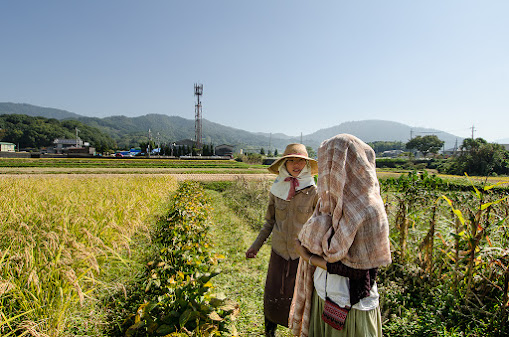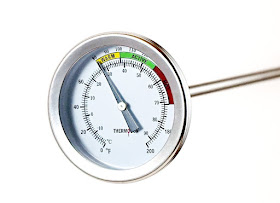The main key to growing hot chillies in cold climates is apparently temperature and humidity. Chillies hate the cold! 'The hotter the chilli, the more temperature dependant it is and the longer it will take for the seeds to germinate and the plant to grow to harvest time'. I also want to say thanks to everybody who has contributed to this project in the comments section below. It has been a real collaborative effort!
So, after some very extensive scientific research, here are my complete results:
The seeds can be sown in a good quality compost in multi cell trays and germinated in a warm place. Sometimes, especially with the hotter varieties, germination can take up to 4 weeks and so investing in a temperature controlled propagator unit might be a good idea. The ideal temperature is between 27 and 32 degrees C and it is important that this temperature does not fluctuate too much. The total possible temperature range is from 21 to 38 degrees C although germination may be more erratic.
The plants need good drainage and hate to be stood in water, so make sure your compost is of the free draining type, if possible. Sand can be mixed in if the compost is too hydrophilic.
Propagators - These vary in sophistication from the basic 8 watt system to the fully controlled 50 w delux versions. I myself chose a 20 w unit with no temperature control as it was cheap. I used a programmable timer to regulate the temperature and covered it with some insulation to keep the heat in. The instructions with the unit do say not to do this, but I don't see why not? The timer was programmed to come on for 40 minutes and then go off for 20 minutes as this kept the soil at a constant 28 degrees C quite nicely. Other options include using a digital water bed heater or a heated floor in your bathroom or an airing cupboard.
Use a digital thermometer to check the temperature stays within the correct range. Put the probe into the soil close to one of the actual seeds to get the best reading.
Seeds can be planted in January through to the end of March and the fruit will take between 80 and 180 days to ripen, depending on the seed variety. Soak the seeds over night in diluted feed solution or for 2 hours in potassium nitrate solution (0.33g per litre) to reduce germination times by up to 50%, and then plant the seeds 5 mm deep. For saved seed, see below.
Use a digital thermometer to check the temperature stays within the correct range. Put the probe into the soil close to one of the actual seeds to get the best reading.
Seeds can be planted in January through to the end of March and the fruit will take between 80 and 180 days to ripen, depending on the seed variety. Soak the seeds over night in diluted feed solution or for 2 hours in potassium nitrate solution (0.33g per litre) to reduce germination times by up to 50%, and then plant the seeds 5 mm deep. For saved seed, see below.
 Water thoroughly with warm water whenever the top of the compost is beginning to look dry, being very careful not to over water. Cold water may 'shock' the seedlings and delay growth.
Water thoroughly with warm water whenever the top of the compost is beginning to look dry, being very careful not to over water. Cold water may 'shock' the seedlings and delay growth.
Check the seed trays every few days or so for dryness and signs of germination. Once the seedlings have emerged they will need to have light so move them onto a window sill or somewhere warm and light. A glasshouse may be too cold at night time to begin with, so in the house may be better.
As the plants grow, they will need potting on so as not to overcrowd the roots. They can also be fed
with liquid food suitable for tomatoes, especially if the leaves start to look a bit pale in colour. The maximum temperature should be 36 degrees C and the plants do enjoy high humidity. The minimum temperature is 16 degrees C so think carefully where the plants should be kept, especially with regards to night time temperatures. In cold climates it's generally going to be a glasshouse, poly tunnel or conservatory and it may even need to be heated/insulated during the night time.
with liquid food suitable for tomatoes, especially if the leaves start to look a bit pale in colour. The maximum temperature should be 36 degrees C and the plants do enjoy high humidity. The minimum temperature is 16 degrees C so think carefully where the plants should be kept, especially with regards to night time temperatures. In cold climates it's generally going to be a glasshouse, poly tunnel or conservatory and it may even need to be heated/insulated during the night time.
The plants can be planted through aluminium foil so that light is reflected back off the top of the soil back onto the underside of the leaves. This can also reduce pests as they can no longer hide from the sunlight underneath leaves any more.
For the fruit to form, the flowers will need to be pollinated either naturally by insects or by hand using an artist's paint brush and the flowers may fall off prematurely if the plants get too cold. Use the paint brush between noon and 3 pm for best results.
The flowers will eventually fall off naturally and the fruit will then grow and can be harvested when they are filled out and become firm crisp and glossy. Pick one fruit to begin with and test it for heat and flavour. Remember, some of the varieties are EXTREMELY HOT! If you do want to maximise the heat of your chillies, stop watering the plants so much when the fruit has formed and if you want to maximise the flavour, keep on watering as normal.
Chillies are ready for harvesting when the pods come away nice and easily from the stalks. Also, upon inspection inside the pods, the seeds should be well developed ie the same size as they were when the originals were planted.
The harvested fruit can be stored very effectively in the freezer and most of the plants themselves can be treated as perennials, with some pruning needed in the Winter season. Dig the plants up, put them in pots and move them to somewhere warm and sunny and free from frost. Next season they will grow back stronger with an earlier and more abundant harvest.
If you are growing one single variety of chili, then save some of the seeds from your chilies for growing next year's plants. F1 hybrids can not be saved, but normal open pollinated varieties work well. Gently dry the seeds just enough to stop them going mouldy and put them in a paper bag or envelope and store them in a dark cool place away from mice. If you do have more than one variety in the same location you will get cross pollination, which will produce a new plant with unknown properties. When you come to use the seeds, wash them for 30 seconds in diluted detergent to remove the waxy natural germination inhibitor, then rinse and soak in water for 2 hours before planting. Some commercially bought seed may also need washing.
Chili plants may not always flower in the first year, especially the hotter varieties, but can be over wintered in a frost free conservatory or glasshouse to get a head start in the next season. The plants should be pruned back hard and watered every now and again dependent on ambient temperatures
If you live where there is a lot of wind staking plants is a must but also helps those plants that have large fruit and/or are heavy producers.











